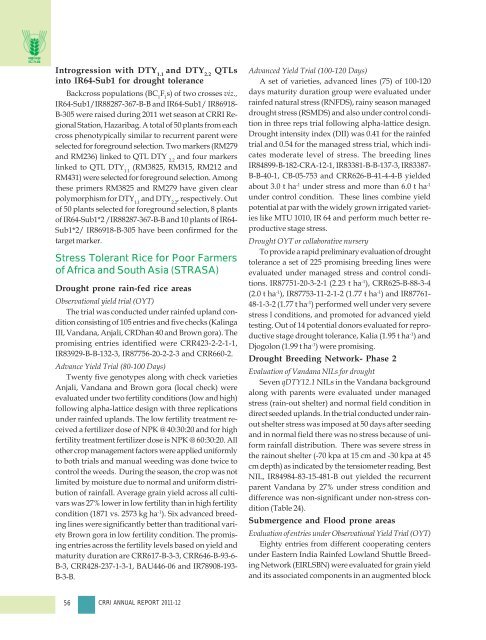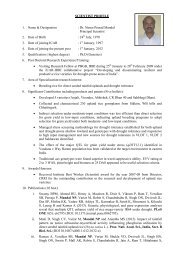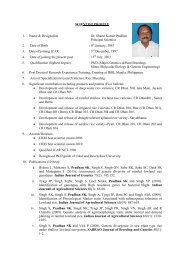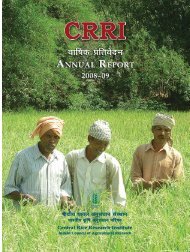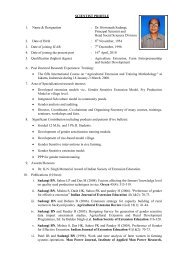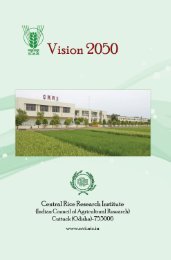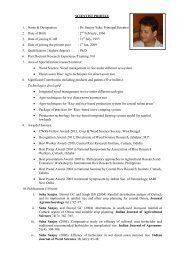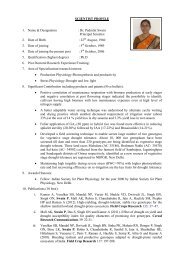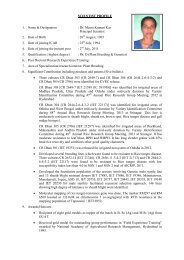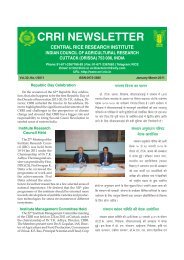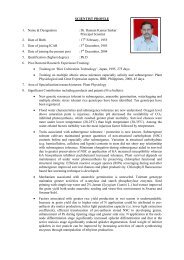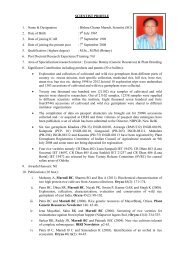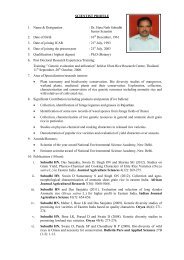Central Rice Research Institute Annual report...2011-12
Central Rice Research Institute Annual report...2011-12
Central Rice Research Institute Annual report...2011-12
You also want an ePaper? Increase the reach of your titles
YUMPU automatically turns print PDFs into web optimized ePapers that Google loves.
Introgression with DTY 1.1<br />
and DTY 2.2<br />
QTLs<br />
into IR64-Sub1 for drought tolerance<br />
Backcross populations (BC 1<br />
F 1<br />
s) of two crosses viz.,<br />
IR64-Sub1/IR88287-367-B-B and IR64-Sub1/ IR86918-<br />
B-305 were raised during 2011 wet season at CRRI Regional<br />
Station, Hazaribag. A total of 50 plants from each<br />
cross phenotypically similar to recurrent parent were<br />
selected for foreground selection. Two markers (RM279<br />
and RM236) linked to QTL DTY 2.2<br />
and four markers<br />
linked to QTL DTY 1.1<br />
(RM3825, RM315, RM2<strong>12</strong> and<br />
RM431) were selected for foreground selection. Among<br />
these primers RM3825 and RM279 have given clear<br />
polymorphism for DTY 1.1<br />
and DTY 2.2<br />
, respectively. Out<br />
of 50 plants selected for foreground selection, 8 plants<br />
of IR64-Sub1*2 /IR88287-367-B-B and 10 plants of IR64-<br />
Sub1*2/ IR86918-B-305 have been confirmed for the<br />
target marker.<br />
Stress Tolerant <strong>Rice</strong> for Poor Farmers<br />
of Africa and South Asia (STRASA)<br />
Drought prone rain-fed rice areas<br />
Observational yield trial (OYT)<br />
The trial was conducted under rainfed upland condition<br />
consisting of 105 entries and five checks (Kalinga<br />
III, Vandana, Anjali, CRDhan 40 and Brown gora). The<br />
promising entries identified were CRR423-2-2-1-1,<br />
IR83929-B-B-132-3, IR87756-20-2-2-3 and CRR660-2.<br />
Advance Yield Trial (80-100 Days)<br />
Twenty five genotypes along with check varieties<br />
Anjali, Vandana and Brown gora (local check) were<br />
evaluated under two fertility conditions (low and high)<br />
following alpha-lattice design with three replications<br />
under rainfed uplands. The low fertility treatment received<br />
a fertilizer dose of NPK @ 40:30:20 and for high<br />
fertility treatment fertilizer dose is NPK @ 60:30:20. All<br />
other crop management factors were applied uniformly<br />
to both trials and manual weeding was done twice to<br />
control the weeds. During the season, the crop was not<br />
limited by moisture due to normal and uniform distribution<br />
of rainfall. Average grain yield across all cultivars<br />
was 27% lower in low fertility than in high fertility<br />
condition (1871 vs. 2573 kg ha -1 ). Six advanced breeding<br />
lines were significantly better than traditional variety<br />
Brown gora in low fertility condition. The promising<br />
entries across the fertility levels based on yield and<br />
maturity duration are CRR617-B-3-3, CRR646-B-93-6-<br />
B-3, CRR428-237-1-3-1, BAU446-06 and IR78908-193-<br />
B-3-B.<br />
Advanced Yield Trial (100-<strong>12</strong>0 Days)<br />
A set of varieties, advanced lines (75) of 100-<strong>12</strong>0<br />
days maturity duration group were evaluated under<br />
rainfed natural stress (RNFDS), rainy season managed<br />
drought stress (RSMDS) and also under control condition<br />
in three reps trial following alpha-lattice design.<br />
Drought intensity index (DII) was 0.41 for the rainfed<br />
trial and 0.54 for the managed stress trial, which indicates<br />
moderate level of stress. The breeding lines<br />
IR84899-B-182-CRA-<strong>12</strong>-1, IR83381-B-B-137-3, IR83387-<br />
B-B-40-1, CB-05-753 and CRR626-B-41-4-4-B yielded<br />
about 3.0 t ha -1 under stress and more than 6.0 t ha -1<br />
under control condition. These lines combine yield<br />
potential at par with the widely grown irrigated varieties<br />
like MTU 1010, IR 64 and perform much better reproductive<br />
stage stress.<br />
Drought OYT or collaborative nursery<br />
To provide a rapid preliminary evaluation of drought<br />
tolerance a set of 225 promising breeding lines were<br />
evaluated under managed stress and control conditions.<br />
IR87751-20-3-2-1 (2.23 t ha -1 ), CRR625-B-88-3-4<br />
(2.0 t ha -1 ), IR87753-11-2-1-2 (1.77 t ha -1 ) and IR87761-<br />
48-1-3-2 (1.77 t ha -1 ) performed well under very severe<br />
stress l conditions, and promoted for advanced yield<br />
testing. Out of 14 potential donors evaluated for reproductive<br />
stage drought tolerance, Kalia (1.95 t ha -1 ) and<br />
Djogolon (1.99 t ha -1 ) were promising.<br />
Drought Breeding Network- Phase 2<br />
Evaluation of Vandana NILs for drought<br />
Seven qDTY<strong>12</strong>.1 NILs in the Vandana background<br />
along with parents were evaluated under managed<br />
stress (rain-out shelter) and normal field condition in<br />
direct seeded uplands. In the trial conducted under rainout<br />
shelter stress was imposed at 50 days after seeding<br />
and in normal field there was no stress because of uniform<br />
rainfall distribution. There was severe stress in<br />
the rainout shelter (-70 kpa at 15 cm and -30 kpa at 45<br />
cm depth) as indicated by the tensiometer reading. Best<br />
NIL, IR84984-83-15-481-B out yielded the recurrent<br />
parent Vandana by 27% under stress condition and<br />
difference was non-significant under non-stress condition<br />
(Table 24).<br />
Submergence and Flood prone areas<br />
Evaluation of entries under Observational Yield Trial (OYT)<br />
Eighty entries from different cooperating centers<br />
under Eastern India Rainfed Lowland Shuttle Breeding<br />
Network (EIRLSBN) were evaluated for grain yield<br />
and its associated components in an augmented block<br />
56 CRRI ANNUAL REPORT 2011-<strong>12</strong>


